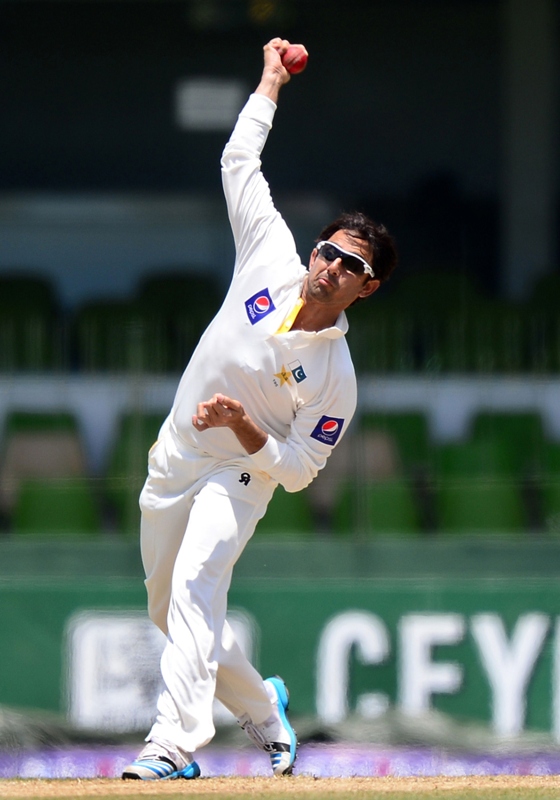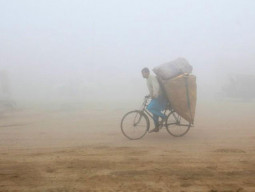
The 36-year-old was banned on Tuesday after failing tests in an Australian biomechanics lab ordered when umpires reported his bowling action during last month's Galle Test against Sri Lanka.
Pakistan Cricket Board (PCB) chairman Shaharyar Khan told AFP that Ajmal's arm had vastly exceeded the permitted 15 degrees of straightening.
"Some of the deliveries had very high elbow extension, over 40 degrees," Khan said of the 23-page report on the tests.
Under International Cricket Council (ICC) rules, a bowler is allowed to straighten his elbow by a maximum of 15 degrees while bowling -- any more is deemed to be throwing, or "chucking".
Khan said it was not just occasional deliveries that were a problem -- the average extension during Ajmal's deliveries was also very high.
"The mean of Ajmal's deliveries was 37 degrees which again is high and now we have a challenge to do the remedial work," said Khan.
Ajmal will appear before a PCB committee on illegal deliveries on Monday to start work to bring his action back within the rules.
Ajmal ban rouses Pakistan to action on 'chucking'
The ban slapped on star spinner Saeed Ajmal has left Pakistan's cricket chiefs frantically trying to take action on "chuckers", including dusting off expensive biomechanical testing kit that had laid unused for years.
Ajmal, who turns 37 next month, was suspended from international cricket on Tuesday after biomechanical analysis found his bowling action, reported during the Galle Test against Sri Lanka last month, to be illegal.
He must now undergo remedial work on his action, and PCB chairman Shaharyar Khan acknowledged chucking was rife in the domestic game.
"I was informed 25 suspected bowlers had been playing in our domestic cricket and now the number has increased up to 35, that means every team has at least two suspected bowlers," said Khan.
Former captain and ex-PCB director of National Cricket Academy (NCA) Aamir Sohail said there were warning signs for Ajmal, who has bowled more balls than any other international bowler in the last three years.
"I had warned in February this year that Ajmal will be suspended because his action was deteriorating with age, but no one heeded. I had recommended his action be checked every year," he told AFP.
Former opening batsman Sohail, who played 47 Tests and 156 ODIs for Pakistan, said there had been a total lack of interest in dealing with bowlers with suspect actions.
"We are ourselves to blame," Sohail told AFP. "We have a biomechanic lab in NCA which I activated and gave a list of bowlers to test there, but the lab remained ineffective for years."
The NCA has equipment to test bowlers to check they are not straightening their arm more than the permitted 15 degrees in delivering the ball.
But the $440,000 kit, which includes 18 cameras supporting apparatus and computer software, has gathered dust since it was bought in 2009 as successive PCB chiefs dismissed the need for it.
Cleared of chucking due to a congenital defect of his elbow in 2009, Ajmal came under suspicion again this year when England paceman Stuart Broad and former captain Michael Vaughan queried his action while the Pakistani was taking wickets at will in county cricket.
In June the International Cricket Council's cricket committee recommended a stricter approach on illegal actions.
That snared Sri Lanka's Sachitra Senanayake and New Zealand's Kane Williamson -- both suspended in July -- and then attention turned to Ajmal.
His ban is a huge blow for Pakistan as he has led the team's attack almost single-handedly across all three formats and was seen as key to their chances in next year's World Cup in Australia and New Zealand.
Head coach Waqar Younis faces a daunting task in finding a replacement for one of the world's best bowlers.
The ban comes at a particularly difficult moment, with Pakistan facing a tough series against Australia in the United Arab Emirates next month.
"Of course, it's a blow," Waqar told AFP. "The timing is unfortunate but life goes on and we have to find a replacement as quickly as possible or hope Ajmal gets back after getting cleared."
Possible replacements include the under-performing Abdur Rehman and ageing Zulfiqar Babar -- both left-arm spinners -- who have spent the last few years in Ajmal's shadow.
The team management has also summoned off-spinners from the domestic circuit, with prolific wicket-takers Atif Maqbool and Adnan Rasool seen as front-runners.
But even these players have had questions over their bowling actions at domestic level -- indeed Rasool modelled his on Ajmal's.
Mohammad Akram, head coach at NCA, said the process of eliminating bowlers with suspect actions would take time.
The fact Ajmal has been the team's pre-eminent bowler for some time makes matters even more difficult.
"Youngsters used to model their actions on Wasim (Akram) and Waqar in 1990s, but now they model their actions on Ajmal," said Akram.
"We have to take steps to help youngsters get clean actions."
For Pakistan cricket's future, actions are now far more important than words.
COMMENTS (1)
Comments are moderated and generally will be posted if they are on-topic and not abusive.
For more information, please see our Comments FAQ

















Yet most pakistanin will defy logic and continue to blame BCCI, calling it unfair to suspend a bowler with an illegal action which exceeds the double the permissible limit. As evident from the news ajmal and let there be no doubt i have huge respect for him, has aged and his action has depleted over the years in the same manner the biomechanic lab has over the years. The PCB is itself to blame for not making use of the available technology in due time. I would love to see him back in action but my question is whether it is fair on all the batsmen who have to face a bowler with illegal arm action ? NO, so please bury the hatred for india and look at the cause of problem.